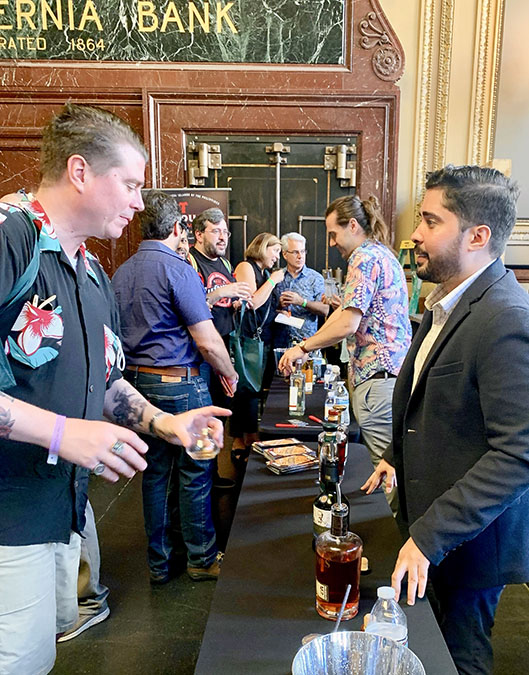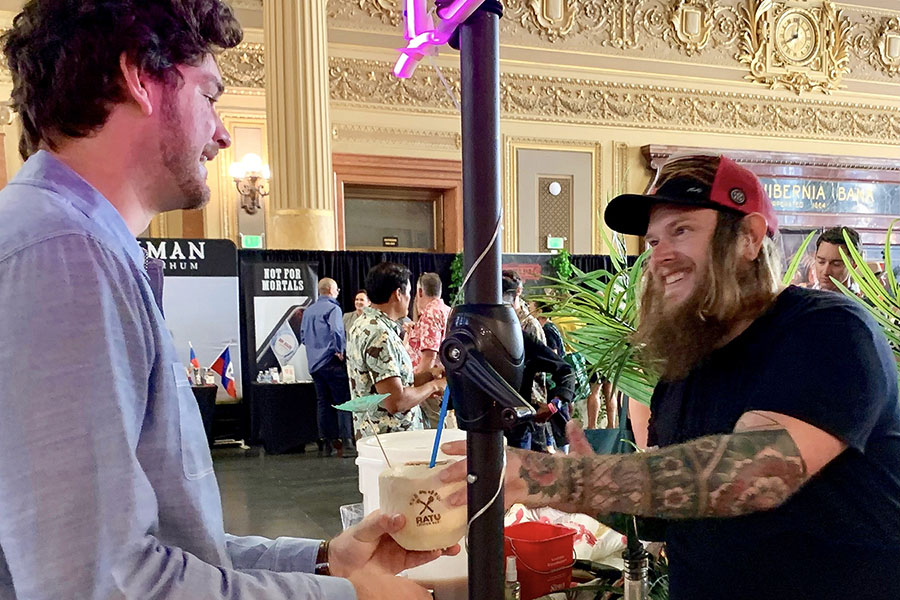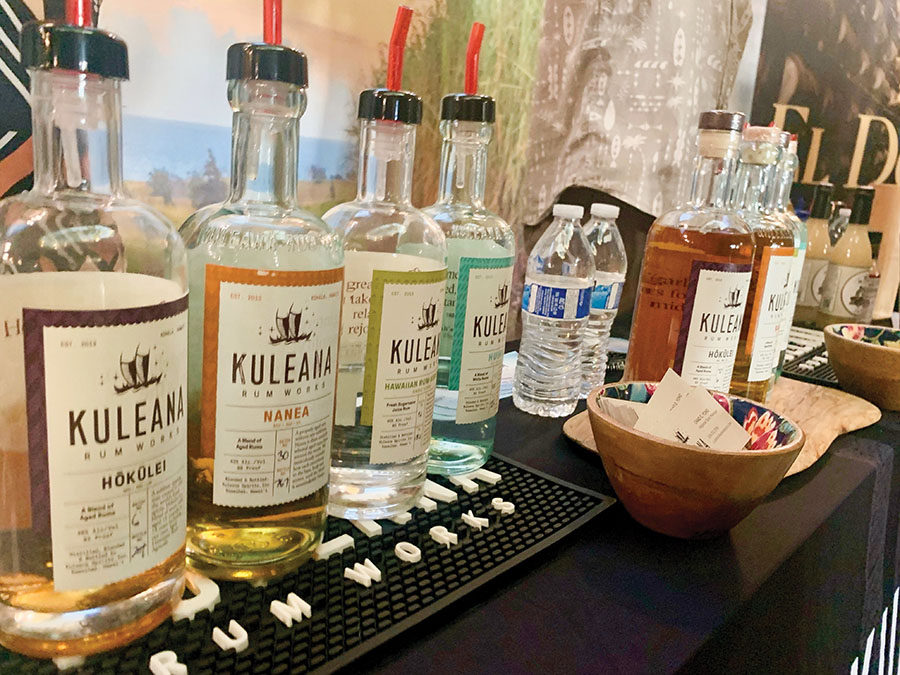A cavalcade of creative distillers are out to change rum’s notoriety, ditching the images of tipsy, yo-hoing pirates and fast-flowing yacht swill and replacing them with the allure of an exquisitely cultivated, multidimensional spirit.
Yet many producers don’t necessarily think establishing a sense of refinement means taking the fun out of rum. The spirit’s connection to cocktails is an association that reaches all around the world. Some craft distillers are leaning into that by using new, innovative, or rediscovered drink recipes to showcase the elevated art coming out of their barrels.
The phenomenon was on full display at the recent San Francisco Rum Festival. Held on September 4, 2022, the event brought together rum makers from as far afield as France, Jamaica, Haiti, and the South Pacific. They were all uncorking their bottles inside the city’s Hibernia Bank, a looming stone masterpiece of Beaux Arts architecture near the edge of the Tenderloin. This vault-like marvel from California’s frontier days was a fitting atmosphere to contemplate rum’s future: According to Gold Rush historian Gary Noy, author of Hellacious California, fortune seekers from around the globe brought their favorite spirits and drinking traditions to the avenues just outside the Hibernia beginning in 1849. And, as those culture-bearing customs started mixing and colliding inside the mining camps, the first ingredients of America’s cocktail legacy began to materialize.
Then, in 1863, the trailblazing cocktail chronicler Jerry Thomas was put in charge of the saloon for San Francisco’s Occidental Hotel, just six blocks north of where the Hibernia Bank now stands. That means the city’s Rum Fest is held in a corner of the West where Thomas helped launch the nation’s drink-stirred flourishes. Some distillers descending on the festival are determined to take recipes from those days of yore and steer them toward new horizons. Cocktails, most agreed, are still a solid way of raising rum’s reputation.
“In the U.S. market, rum is a cocktail sell,” stresses Chase Babcock, co-founder of the Saint Benevolence distillery in Haiti and participant in the event. “If the flavors, like we have in our rum, are really interesting, then they shine through in a cocktail.”

Beyond a Party Pour
Hosted by the Rum Lab, the 2022 festival in California’s Bay Area had a clear theme: This isn’t your frat house’s spirit anymore.
That much was clear in a tasting seminar led by Rob McCaughey of the Wine and Spirit Education Trust. McCaughey emphasized that the elements to focus on in craft rum are balance and expressiveness, noting that lately a number of distilleries are achieving flavor mosaics as striking as the most sought-after Scotches and bourbons. When it comes to that, he added, what widens the possibilities are differences between molasses- and sugarcane-based distillations.
“There are things that are intrinsically different in their characteristics,” McCaughey explains. “Neither is better or worse. They’re just choices that are going to get you different results.”
Outside, in the bank’s grand chamber, more than a dozen distillers poured molasses or sugarcane rums for the crowd. Babcock was guiding attendees through an even deeper subcategory, clairin, which Saint Benevolence has specialized in since being founded in 2017. Clairin is a hand-crafted sugarcane rum that is an old Haitian tradition. St. Benevolence uses a mix of fresh cane juice and cane juice that is slow-boiled into syrup outside in the island’s fields during harvest, as the base of its clairin. It’s subjected to a long, open-air fermentation process, then distilled on pot stills.
“Clairin is really Haiti’s ancestral version of rum, and in some ways it’s more like a mezcal,” Babcock says. “It’s really how Haitians have been drinking rum since colonial times. For us, it’s about highlighting a craft and that we have a third-generation distiller whose approach has very few modern influences on its process.”
Given that the proceeds from Saint Benevolence fund education programs and healthcare initiatives in Haiti, Babcock has a lot of motivation to grow the brand. In that respect, he went on, there is no reason to resist the cocktail’s significance. He pointed out that, even though mega-fans at San Francisco’s rum festival were excited to taste the spirit on its own terms, nearly every distillery participating had a cocktail mixed and ready to hand out.

“The market in Europe is way more accustomed to sipping a dry rum,” Babcock admits. “But, here, it’s still a cocktail play.”
Further proof of that could be seen in the longest line at the festival. It wasn’t for any distillery’s table, but rather for The Coconut Guy — a mobile bar that was chopping up fresh coconuts and mixing cocktails inside them. Dustin and Rachel Lynn Ryan, owners of The Coconut Guy, were not surprised that eventgoers wanted their lively concoctions. The couple was working exclusively with Bati Rum at the festival, a white rum made in Fiji that is named for the island’s formidable warriors who once guarded their sacred ground. Dustin was offering up his own special take on a Rum Runner, which swaps in coconut water for banana liqueur – and which attendees seemed to love.

2022’s San Francisco Rum Festival. Photograph by Scott Thomas Anderson
For Rachel, people carrying elaborate coconuts filled with Bati Rum was a perfect fusion for the day. “Because we were working with larger brands, more of the craft rum distilleries are starting to find us and find a place for us,” she says. “Even though these rums are so wonderful by themselves, they’re just enhanced with a little coconut water and lime, and then the cocktails don’t have to be as difficult and involved as a tiki drink. It can be very simple, so that the rum is still really forward; but it’s a perfect marriage.”
Asked why drinkers just can’t shake their visions of rum cocktails, Rachel thought for a moment before replying, “People can kind of view these as a dream vacation in a glass.”
Growing Fame from Festivals
One person energetically pouring at San Francisco’s rum festival was Karith Sudhir, founder of Phenomenal Spirits, a rum and whiskey blending house in Virginia Beach, Virginia. Sudhir has glowing memories tied to a similar event in 2018, when he launched himself as a rum producer by taking a big gamble on appearing at The Paris Rum Festival. Sudhir’s hand-crafted blends weren’t commercially available yet, but he made the investment to fly across the Atlantic to offer them at one of the world’s most discerning collections of rum aficionados.

“I thought I might as well go and take the chance to see if I could get that validation,” Sudhir reflects. “I said, ‘If I can make it in France — if I can sell it there — I’m golden.”
On Sudhir’s first day at the Paris summit, he sat alone at his booth. Virtually no one tasted what he had made. On the second day, a few Parisians tried it, then brought their friends, which launched a snowball effect that put him at the center of a constant crowd. Ever since that nail-biting liftoff toward success four years ago, Sudhir hasn’t been nervous at events like San Francisco’s Rum Fest. Looking back, he acknowledges he was no stranger to rolling the dice. He first immigrated to the U.S. when he was 24, arriving with exactly $400 in his pocket. Nineteen years later, he left a successful career in the tech industry to follow his heart into spirit making.
“Pursuing a passion was more important to me,” he says. “I still love tech, but, for me, this has been the most intricate and challenging thing I’ve ever done in my life.”
Today, Sudhir’s Central American rum brand, Ron Izalco, is starting to get international attention. Named after the looming Izalco volcano in western El Salvador — one of the so-called “lighthouses of the Pacific” — the brand blends rums from five different distilleries located near the equator. Ron Izalco’s 10 Year Rum is a cask-strength, unadulterated spirit that’s aged in bourbon barrels, conjuring a hint of fiery oak ahead of its long, alluring finish. Ron Izalco’s 15 Year Rum is even more layered, elevated by touches of tobacco, pings of earthiness, and the slightest hint of leather. It’s what Sudhir considers a cigar-bearing, serious drinking spirit.
Either of Ron Izalco’s offerings might get an avid bourbon drinker’s attention, yet Sudhir is absolutely comfortable marketing them through certain cocktails. He recommends some of America’s old standards that are otherwise whiskey or rye-based.
“It’s the signature cocktails,” he says. “For example, when you’re making a Sazerac, you can substitute rye whiskey with rum. Or you can even do it with a Manhattan. Some of the classics, like the Vieux Carré, it’s fantastic to change the rye with an aged, Spanish-style molasses rum. You’re stirring it with the Cognac and Benedictine — all that good stuff — and it makes an amazing craft cocktail.”
Four days after San Francisco’s Rum Fest, Sudhir was 80 miles north in Sacramento hosting a private tasting for spirit connoisseurs. He decided to introduce the Ron Izalco 10 Year Rum to this crowd by using a World War I–era Caribbean cocktail well associated with aged rum: the Dark and Stormy. Many of the tasters agreed that the ten-year blend gave the Dark and Stormy an especially bright, electric tingle. Sudhir saw the cocktail as an enjoyable way for these new friends to prep for a broader conversation about ultra-premium rums.
“Rum is a very, very fast-emerging category — the scope of it is immense,” he observed at the Elk’s Tower. “Younger whiskey drinkers are constantly testing their palate, so events like the San Francisco Rum Festival, and tonight, are great audiences for me. We’re not here to conquer the world; we’re here to conquer the whiskey drinkers.”
The Voyage from Past to Future
Hawaiians have been venturing into San Francisco since gold was first discovered in the hills viewed from its bay in 1849. They called the city Kapalakiko. By the 1860s, Hawaiians represented the largest cultural diaspora within Fog City, according to the SF Natural History series. Given that background, it was only proper that a distiller who was born and raised in the islands rarely stopped pouring his rum at San Francisco’s latest festival.

Steve Jefferson founded Kuleana Rum Works with some serious historical and biochemical ambitions. A former journalist in Hawaii, Jefferson was spending a year sailing the world with his wife, Jackie, and their two small children when he had an epiphany in French Polynesia. He was touring a volcanic slope in Martinique that reminded him of the Big Island back home. Jefferson noticed its Depaz sugarcane plantation, which had its own rum distillery, and tried what was being made there.
“It was just, ‘Slam on the brakes!’” Jefferson recalls. “I told them, ‘I’ve never had anything like this.’ They said, ‘That’s because you Americans like sweetened stuff, and you like flavored stuff, so we send all this rhum agricole to France.’”
Jefferson immediately started talking to Jackie about going home to start a distillery.
By 2012, the couple were growing scores of sugarcane plants in pots and five-gallon buckets in their yard on the Big Island. They weren’t just harvesting any canes, either: A Stanford University researcher, Dr. Noa Lincoln, had determined they were not, in fact, growing the common holdovers from the Hawaiian plantation system, but instead a rare heirloom variety of sugarcane brought by the first wave-bound pathfinders to arrive in Hawaii in the 4th century C.E., Polynesian migrants who came to be known as the “Argonauts of the Pacific.” That means Kuleana’s distillery isn’t just making fresh sugarcane rum — it’s making a spirit from “canoe plants” literally handed down through the ages.
“Very few people realize that Hawaiians had their own cane thousands of years before anybody else,” Jefferson observes. “Really, what we’re trying to do with this company is share this culture of Hawaii, which is very long-term — hard choice, easy life — as opposed to easy choices, hard life.”
But there’s nothing hard about drinking inside the bar and restaurant that Kuleana Rum Works opened on the Big Island to showcase its products. Jefferson said the place has become a kind of lab of experimentation for rum cocktails. His mixologists have a mantra that there is no cocktail that can’t be made, and made better, with rum. One of the drinks they have focused on is the Old Fashioned: They substitute an agricole-style rum that’s been aged for 18 months in Cognac barrels and blended with four other rums for the traditional whiskey in an Old Fashioned, along with a smaller amount of Kuleana’s white rum.
“People coming in will say, ‘Oh, that was fantastic, what is that?”’ Jefferson observes. “When we tell them, it blows their mind.”
The other cocktail that’s on fire in Kuleana’s bar is what the team calls an O.G. Mai Tai. It’s made with orgeat, fresh lime juice, a little orange liqueur, and at least two kinds of rum — a light rum and an aged rum — with a splash of bitters on top. That, Jefferson said, is the cocktail’s actual roots.
“Something happened between 1944, when the Mai Tai was invented, and today,” he remarks. “It happened in Waikiki — they started putting in all these fruit juices. There’s not supposed to be pineapple juice. There’s not supposed to be orange juice. It got perverted into something unrecognizable. And so, when we opened up our bar program, we went back to the original so we’d have a cocktail that really shows what rum can do. The good news is that it’s been very successful and we’re the highest-rated cocktail bar on the island.”
Jefferson added, “In order to showcase rum as a world-class spirit, we had to make world-class cocktails.”








